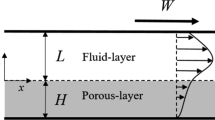Conclusions
-
1.
Relation (8) was established, according to which the coefficient of aeration of a rapid uniform flow (coefficient of stabilized aeration), regardless of the roughess of the bed, is uniquely determined by the measure of the dissipation of specific energy — its gradient (I).
-
2.
Relation (15), being a more accurate realization than (4) of relation (8) for cross sections bounded by a conditional free surface with a local value of the water saturation coefficient βloc=0.01−0.02 (a loc=0.99−0.98), was developed. Relation (15) is recommended for engineering calculations in the entire practical range.
-
3.
The establishment of relation (8) clears up the problem of modeling the phenomenon of stabilized aeration in prismatic channels, reducing it to the condition I=idem, with simultaneous provision of the necessary path length of stabilization.
-
4.
Relation (6) does not correspond to the actual data on aeration of rapid flows.
Similar content being viewed by others
Literature cited
V. P. Nedrigi (ed.), Designer's Handbook. Hydraulic Structures [in Russian], Stroiizdat, Moscow (1983).
P. G. Kiselev (ed.), Handbook of Hydraulic Calculations [in Russian], Énergiya, Moscow (1972).
V. A. Bol'shakov (ed.), Hydraulics Handbook [in Russian], Vishcha Shkola, Kiev (1977).
N. B. Isachenko, “Effect of spillway surface roughness on the degree of air saturation of the flow,” Izv. VNIIG,78 (1965).
O. M. Aivazyan, “New method of hydraulic calculation of chutes with increased roughness, Tr. MGMI,52 (1977).
O. M. Aivazyan, “Investigations of tranquil and rapid flows in smooth and reinforcedconcrete flume channels,” Gidrotekh. Stroit., No. 2 (1984).
O. F. Vasil'ev, G. P. Skrebkov, N. B. Isachenko, and V. S. Sinel'shchikov, “Investigations of the aerated flow on the chute of the Ak-Tepe hydroelectric station,” Izv. VNIIG78 (1965).
A. A. Nichiporovich, “Tests of the chute of the Erevan hydroelectric station,” Gidrotekh Stroit., No. 4–5 (1931).
A. A. Nichiporovich, “Results of testing the chute of the Gizel'don hydroelectric station,” Gidrotekh. Stroit., No. 5 (1934).
A. D. Al'tshul', Hydraulic Resistances [in Russian], Nedra, Moscow (1982).
N. B. Isachenko, “Contribution to the problem of aeration of open-channel flows,” Izv. VNIIG,68 (1961).
O. Aivazian, “Calculo hidraulico de rapidas con rugocidad intencuficada,” Voluntad hidraulica, No. 25, Havana, Cuba (1973).
R. Ehrenberger, “Eine neue Geschwindigkeistsformel für künstliche Gerinne mit starken Neigungen (Schusstennen) und Berechnung der Selbstbelüftung des Wassers,” Die Wasserwirt schaft, No. 28–29 (1930).
L. G. Straub and A. G. Anderson, “Experiments on self-aerated flow in open channels,” Proc. ASCE, Paper 1890, HY 7 (1958).
L. G. Straub and A. G. Anderson, “Self-aerated flow in open channels,” Trans. ASCE,125, 456–486 (1960).
A. G. Anderson, “Influence of channel roughness on the aeration of high-velocity, open-channel flow,” International Association of Hydraulic Research, Congress XI, Leningrad (1965).
Aerated Flow in Open Channels. Progress Report. Proceed. of the ASCE, Paper 2814, J. Hydraulics Division, No. HYE, May (1961).
Additional information
Translated from Gidrotekhnicheskoe Stroitel'stvo, No. 12, pp. 33–40, December, 1986.
Rights and permissions
About this article
Cite this article
Aivazyan, O.M. Stabilized aeration on chutes. Hydrotechnical Construction 20, 713–722 (1986). https://doi.org/10.1007/BF01425070
Issue Date:
DOI: https://doi.org/10.1007/BF01425070




